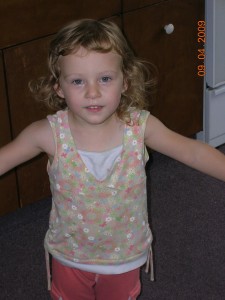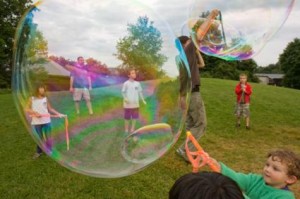By Kelly Bartlett, certified positive discipline educator and leader of API of East Portland, Oregon USA
 Positive discipline doesn’t come instinctively for many people. In fact, that’s why most parents endeavor in positive discipline in the first place; they want to change their current instincts about raising children. They want to break the cycle of using traditional discipline methods that compromise the parent-child relationship, and they are forging their way in a new direction. As opposed to parenting with strict control and scare tactics, when children are raised with kindness and respect, parents are instilling a new instinct for discipline. Children learn how to solve problems, manage difficult emotions, and make intrinsic decisions about what’s right and wrong. Positive discipline is a parenting approach that is based on connection and trust, rather than on longing and fear.
Positive discipline doesn’t come instinctively for many people. In fact, that’s why most parents endeavor in positive discipline in the first place; they want to change their current instincts about raising children. They want to break the cycle of using traditional discipline methods that compromise the parent-child relationship, and they are forging their way in a new direction. As opposed to parenting with strict control and scare tactics, when children are raised with kindness and respect, parents are instilling a new instinct for discipline. Children learn how to solve problems, manage difficult emotions, and make intrinsic decisions about what’s right and wrong. Positive discipline is a parenting approach that is based on connection and trust, rather than on longing and fear.
However, while the theory has remarkable appeal, many parents are skeptical to begin the journey into positive discipline. It seems doubtful that any deviation from what has, up until now, seemed like the “normal” way to parent children is going to work. Or more likely, that a different approach will work more effectively. This reluctance is natural. After all, it goes back to instincts; parents naturally turn to the same methods with which they were raised. The thought of doing anything differently can bring on resistance:
“It’s too much work.”
Going from a reactive discipline approach to one that’s primarily proactive can feel very intimidating. Positive discipline takes the cultural belief about discipline and turns it on its head. When parents are accustomed to responding to children’s behavior with yelling, threats, and punishments, it is difficult to stop and re-think how to respond using the language of positive discipline. Indeed, much like learning a new language, learning positive discipline skills also takes time and practice.
Parents can take baby steps in the direction they want to go by substituting one positive discipline tool in place of a corresponding traditional one. For example, to raise kids who are problem solvers, focus on solutions instead of issuing punishments. To raise kids who are effective communicators, ask questions and listen instead of lecturing. To raise kids who are internally motivated, say “thank you” instead of “good job.” For every attribute parents aspire to teach their children, there are baby steps they can take to get there. Start with one; step by step, you will soon see great strides.
“It takes too long to see results.”
While it’s true that traditional discipline aims to stop unwanted behavior now, positive discipline works toward a bigger goal than the immediate present. Most of the positive discipline tools are proactive, rather than reactive. This means they won’t elicit the same results as traditional discipline methods. For many parents, this can be frustrating when trying to manage difficult behavior.
Glenda Montgomery, a certified postive discipline educator with the Positive Discipline Association, likens positive discipline to a dance. She tells parents, “Imagine that throughout these years, you’ve been in a dance with your child. You know all of each other’s moves. You know each other’s actions and consequent reactions. Now suddenly, [by using positive discipline] you’re changing the dance routine. You are moving in a new direction while your child is continuing with the same moves as before. Their moves might even be more pronounced than usual as your child tries to lead you back into a familiar dance routine. It’s going to take some time for everyone to get in sync with the new moves.”
Yes, it does take time to see significant results with positive discipline. Consider the adage, “If at first you don’t succeed, try try again.” If your first attempt at using a positive discipline tool doesn’t succeed in changing behavior, try it again. And again. Perhaps try a different tool. And try that one again. What all of these tries add up to over the course of the growth of the child is a new “dance”; a new relationship between the two of you and a new perspective for seeing disciplinary results.
“Life is not ‘positive’.”
In the “real world,” there are consequences for poor behavior and rewards for good behavior. If you break a law, you are punished with jail time. If you excel at your job, you are given a bonus. If you drive too fast, you get a ticket. If you travel enough, you get status perks. The world is full of conditions. This makes many parents want to adopt a punishment-and-reward system at home with prizes, timeouts, sticker charts, and losses of privileges, so children can grow up experiencing what the “real world” is like.
Jane Nelsen, PhD, author of Raising Self-Reliant Children in a Self-Indulgent World, argues that there are much more effective ways to teach children about developing sound judgment skills to succeed in the real world, without mimicking the punishments and rewards that are intended for adults in an adult system. She says that moral and ethical development requires not the enforcement of external provisions, but “a mentorship between children and adults.” The best way to help children develop sound judgment is to give them the opportunity to practice.
This means parents must refrain from making all of their children’s decisions for them and must provide them with opportunities to think through their own choices; to make mistakes. When parents do this, and allow their children to fully experience the consequences of their mistakes without being rescued, children learn much more efficiently the effects of their actions. Dr. Nelsen says, “When young people discover that their choices affect their outcomes, they feel potent and significant and become increasingly confident that they hold the reins in their lives. With practice, they become more adept in holding these reins — and better human beings.”
Because children are not on the same developmental level as adults, emotionally or cognitively, they do not need “practice” in experiencing punishments intended on an adult level in an adult world. What they need from parents are discipline strategies that focus instead on problem solving and communication. They need to cultivate problem solving skills and internal motivation for doing what’s right. In short, they need to develop sound judgment now (through experiencing mistakes and solving problems), so they will inherently avoid the legal system later when they’re in the “real world.”
“It rewards poor behavior.”
Because positive discipline involves no punishments and lots of connection, it is often first seen as permissive. It makes more sense to parents to threaten a consequence to stop a tantrum than to scoop a screaming child up for a hug. Isn’t doling out hugs instead of consequences just rewarding bad behavior? It’s easy to see how positive discipline challenges mainstream thought about behavior. It moves from a behaviorist approach — offering superficial solutions to control innate human behavior — to a connected, communicative one. It aims to first understand — to get at the root of human needs — then to guide. Positive discipline is connection before correction.
It is possible to reconsider the idea that human behavior must be manipulated and controlled by a set of external stimuli (punishments and rewards). Parents can remember that, unlike animals, children’s behavior is a direct reaction to their feelings, and those feelings stem from genuine needs. Because difficult behavior in a child is a result of an unmet need, parents can first pause to assess what that child might be feeling, and therefore needing, before being too hasty to chastise the behavior. As human brains are more complex than those of any other animal, positive discipline methods, as opposed to behaviorist strategies, are aimed at changing behavior by specifically addressing those complexities. So although for many parents it may seem like positive discipline methods reward undesirable behavior, they in fact do not. It’s not a “carrot and stick” approach to manipulating behavior; rather it regards behavior at its source on a uniquely emotional level. Positive discipline addresses behavior at its core, without merely treating its symptoms.
“I’m alone in this.”
More often than not, parents meet other parents who are unfamiliar with the concept of positive discipline, than those who use it regularly in their families. Sometimes, it’s even within the same family that parents disagree on how to discipline. Spousal differences or grandparent disparities may convey many of the resistances described above, and make it seem difficult for a family to succeed in their positive discipline efforts.
There is support available for helping parents succeed with positive discipline! No matter where you are on your journey, there are various forms of education, inspiration, and encouragement. In-person positive discipline classes are available in states across the country, and they offer inspiring evenings of learning, activities, and connection with like-minded families. It is immensely helpful for parents to be able to connect with other moms and dads who are also on a positive discipline journey. Online or in person, parents come together to create a network of support for each other. They’re there to encourage, commiserate with, and bounce ideas off of each other. Parents should surround themselves with positive discipline enthusiasts; create networks of support to help themselves succeed.
Find more information on local positive discipline workshops, as well as online support, at www.positivediscipline.com. Also available is a downloadable iPhone app in which parents can conveniently have the 52 Positive Discipline Tool Cards always at their fingertips.
Learning positive discipline takes a lot of thought, effort, and most importantly, a huge shift in paradigm. Discipline approaches change from reactive to proactive. Discipline tools change from “what can I do to my child” to “what can I do for my child.” And discipline strategies change from quick-fix to long-term. Despite the initial effort involved, the payoff is life-long for family unity, parent-child relationships, children’s well-being, and even children’s future families. It is absolutely possible and undoubtedly worth the investment to work on creating new instincts for raising secure, confident children.
 So often, as parents, we try to prevent our kids from making mistakes. We issue warnings, reach out to help, or just do a job ourselves because we don’t want the hassle of fixing a mistake like a spill, fall, or ill-thought decision. But making mistakes is valuable and necessary for a child’s learning and development of self-confidence. How we handle mistakes can teach children that challenges are either threats to be avoided, or that they can be opportunities to learn and develop strong mastery skills.
So often, as parents, we try to prevent our kids from making mistakes. We issue warnings, reach out to help, or just do a job ourselves because we don’t want the hassle of fixing a mistake like a spill, fall, or ill-thought decision. But making mistakes is valuable and necessary for a child’s learning and development of self-confidence. How we handle mistakes can teach children that challenges are either threats to be avoided, or that they can be opportunities to learn and develop strong mastery skills.


